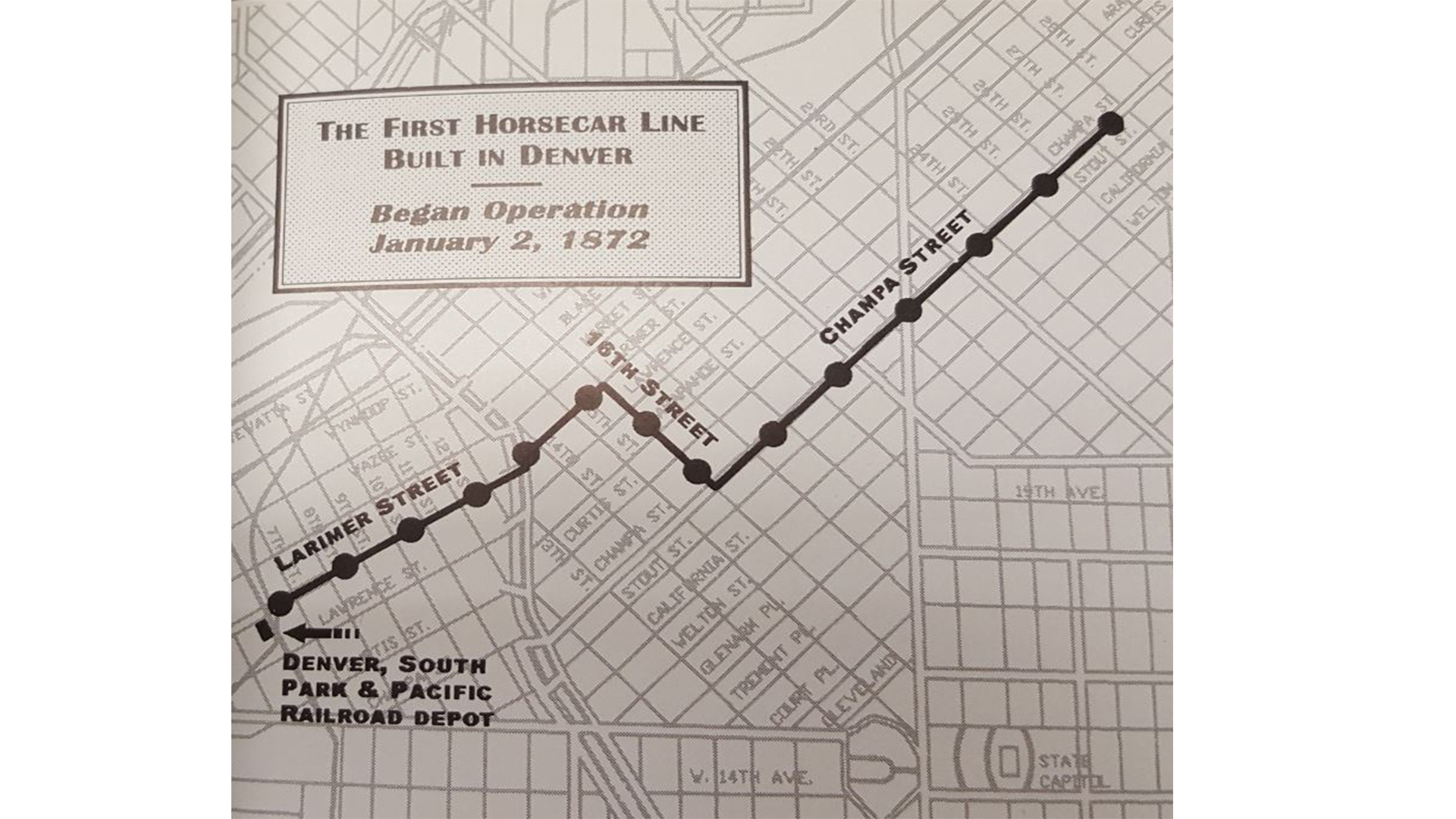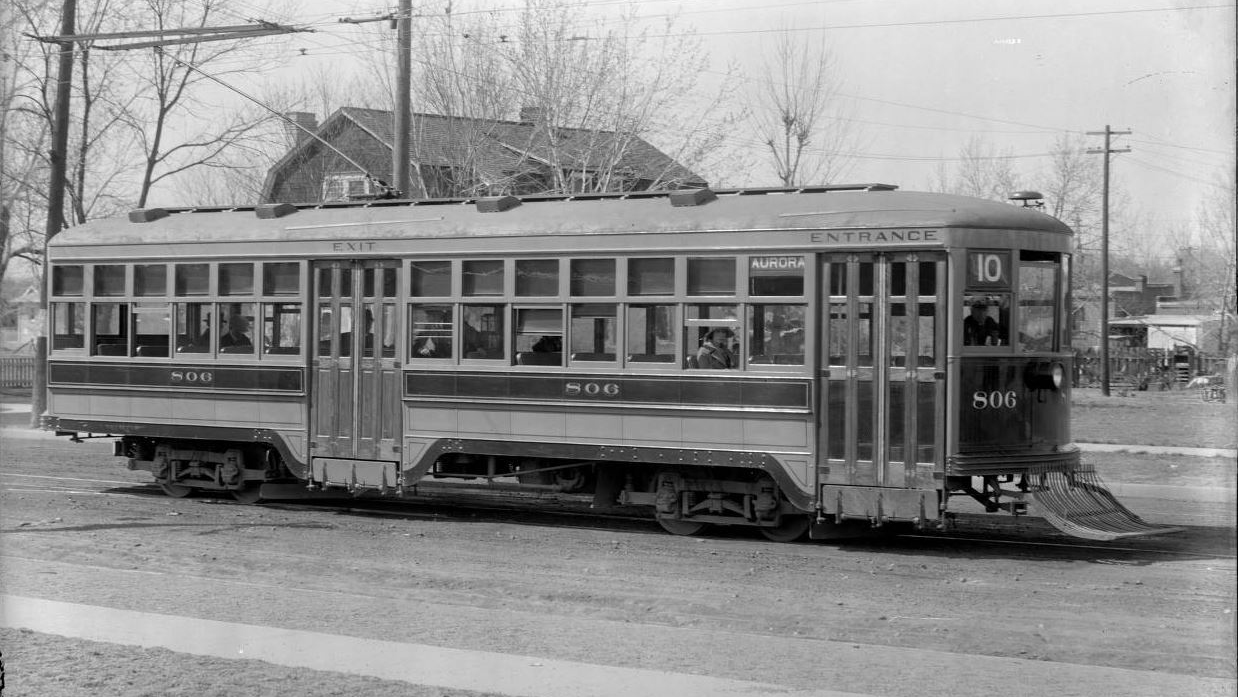This is post number two in a four part series on Denver’s streetcar legacy and its role in neighborhood walkability. For the introductory post, click here. To get the most out of this post, I recommend taking a look at and examine the Streetcar Routes section. This will allow you to look at every streetcar route that ever existed in the modern city proper and filter them using a time slider to see what routes existed during any given year.
Once upon a time, there were no cars in Denver. In 1861, when the city was incorporated, people traveled around town either by foot or by horse. By 1870 the town had grown to a population of about 4,700 people and became large enough to make walking from one side to the other time consuming. Not everybody had the luxury of getting around by their own private or hired horse. In 1872 the Denver Horse Railroad Company built the first public transit line in Denver. It consisted on a horse drawn rail carriage going from Auraria to modern Curtis Park.
By 1880 the trackage had expanded modestly, perhaps doubling in total length, covering an area from Broadway at Speer to Larimer at 33rd going north-south, and Federal to Ogden going east-west. The population in this time however had ballooned seven-fold to 35,000. News reports at the time lamented the inadequate state of the network. In the face of pent-up demand and continued population growth, the 1880s saw the biggest single-decade expansion of the network in its 78-year history.
By 1890, when the population tripled to 106,000, nearly every block in downtown and modern Five Points/RiNo had a streetcar line. Lines covered the full length of Broadway and Colfax, and the northwest side around Berkeley had multiple routes. These lines were built by many fiercely competitive startup companies. Competition was so intense, that on occasion one company would rip up the rails of another while building their own!
New means of conveyance also appeared. Many of the new routes were cable cars (below left). Driven by a central powerhouse, miles of sunken cables moved along next to the tracks, which the cable cars latched onto for propulsion. Additionally, steam engine streetcars were also built, including one which went out to the newly relocated University of Denver campus. In the early 1890s the electric streetcar came on the scene, powered by overhead wires (below right). By the time of the economic Panic of 1893, they had become dominant. The Denver Tramway Company owned the bulk of these superior electrified lines, and was thus better positioned than its competitors.
When I first set out on this digitization project, I wanted to record the means of conveyance of each line. I found this to be impossible however because the network was simply too dynamic and too complicated with all these different companies operating. Oftentimes one street would have multiple companies operating multiple tracks, each with a different propulsion mechanism. I had assumed that the network was operated by one company and grew in an orderly fashion over the streetcar’s whole history. How wrong I was!
The recession in 1893 largely brought a halt to street railway expansion, and ushered in an era of consolidation. Companies merged, and redundant lines were taken out of service. By the new century the Denver Tramway Company emerged with a monopoly on streetcar service operation in Denver. Expansion picked up again in the early 20th century, but at a much slower pace. By this time automobiles had become affordable to a large swath of the population and the Tramway became aware of the threat it posed.
In 1915 they commissioned an interesting survey of the mode share of people traveling in and out of the central business district. 51% rode streetcars, 38% walked, 13% drove automobiles, 6% rode bicycles, 1% drove motorcycles, and 1% used horses. They also found that compared to 1914, streetcar patronage had dropped by 9% and driving had doubled. However in subsequent years the raw numbers of streetcar patronage again increased.
It was around 1917 that the streetcar system reached its peak in terms of coverage (below) with the construction of a line to Barnum. After this was a long decline, with many lines being taken out, and the last new segment being built in 1923. Looking at ridership itself, it peaked in 1910, with 87,819,000 passengers. At the time, 3,000 automobiles were present in the city. By 1928, the number of private automobiles had increased to 78,000 and streetcar ridership declined by 59%.
The late 1920s and early ’30s marked the beginning of the conversion of many rail routes to bus routes but, as in the Panic of 1893, the Great Depression put a stop to this, stabilizing the rail system until 1940. At this time, trolley coaches, which are essentially buses powered by overhead electric wire, along with gasoline buses, began replacing some of the less heavily used streetcar routes. This conversion process didn’t last long though, ending with the removal of rail tracks on 16th Street in July of 1941, because soon the United States became party to World War Two after the Japanese attack on Pearl Harbor. Gasoline and rubber were rationed due to the war effort, causing ridership to increase for the last time, and the system again remained stable until the end of the war in 1945.
After the war the economy boomed and a huge push for modernization in all aspects of life occurred. Many Denverites regarded the streetcars as ancient, noisy, and obsolete. With the advent of larger diesel buses, the removal of the streetcar lines accelerated, and the plurality in terms of transportation mode share that the streetcar had enjoyed since the late 1800s came to an end. By 1951, all streetcar lines were gone and the Denver Tramway became an all bus and trolley coach operation. The electric trolley coaches themselves were taken out of service in 1955.
In the first half of Denver’s history, public transportation in the form of streetcars was the dominant mode of travel that people used to get around. Because of this, most of the city proper was built around these lines. In our next post, we will take a look at how the built environment developed in symbiosis with the streetcars, and how that legacy remains with us today.
~~~
The images of the first horsecar route, the trolley bus, and the color streetcar are from Denver’s Street Railways Volumes I and II. If you are interested in the history of Denver’s streetcars, I highly recommend taking a look at these books, as they are filled with fantastic images and a brilliant historical narrative. They served as my primary data source for the route mapping, along with most of the information in this post. The remaining non-map images are courtesy of Denver Public Library Digital Collections.




















You failed to mention the spider web of wires which cover every route. Because the wires must be mostly at a fixed elevation to connect to the trolley below, there are a lot of support wires. I remember the loveliness of no trolley lines when they tore it apart.
The changeover in the 50s would seem to indicate that buses were considered a better solution than streetcars. The advantage and disadvantage of buses would seem to be flexibility. You can easily move a bus route, but can’t move rail.
A question about streetcars: streetcars seemed to be street level rails sharing the roads with cars and buses. Would the streetcars follow the same rules as the buses? Would other vehicles be able to use the lanes the streetcars operated on?